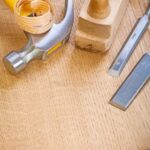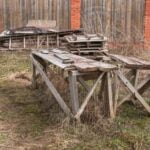Woodwork is often an important feature in homes and furniture, adding a touch of warmth and sophistication to any space. However, when it comes to caring for and maintaining woodwork, it is crucial to know whether it has been waxed or varnished. Understanding the type of finish can greatly impact how you clean, restore, and protect the wood.
In this article, we will discuss the various methods and techniques to determine if woodwork has been waxed or varnished. Whether you are a homeowner looking to properly care for your woodwork or a woodworker interested in restoring antique furniture, this knowledge will prove invaluable.
Differentiating between wax and varnish is essential because they have distinct characteristics and require different approaches for maintenance and treatment. By accurately identifying the type of finish on your woodwork, you can make informed decisions about which products to use, how to clean it properly, and how often it needs to be restored.
Join us as we delve into the key differences between wax and varnish finishes, explore visual inspection techniques, tactile examination methods, chemical tests, reactivity analysis using solvents, expert tips from seasoned woodworkers on accurate identification methods, and the implications of wax and varnish on woodwork maintenance and restoration. With this comprehensive guide at your disposal, you will be equipped with the knowledge needed to preserve the beauty and longevity of your beloved woodwork pieces.
The Difference Between Wax and Varnish
Woodwork can be finished with either wax or varnish, each of which has its own unique characteristics and application methods. Understanding the difference between these two finishes is essential for properly identifying them on woodwork.
Wax is a natural finish that creates a soft, low sheen look on wood. It is typically made from a combination of beeswax, carnauba wax, and other natural ingredients. Wax is usually applied by hand and requires regular reapplication to maintain its protective qualities. One of the main advantages of wax is its ability to enhance the beauty of wood by deepening the color and bringing out the grain patterns. However, it provides minimal protection against moisture and stains.
On the other hand, varnish is a synthetic finish that creates a hard, shiny surface on wood. It is made from a combination of oil, resin, and solvent. Varnish can be applied using different methods such as brushing or spraying, depending on the desired outcome. Unlike wax, varnish forms a durable protective layer that safeguards wood against moisture damage and stains. It also provides a glossy finish that enhances the natural beauty of wood.
To determine whether woodwork has been waxed or varnished, it is important to visually inspect the surface texture and appearance of the wood. Waxed surfaces typically have a softer sheen with minimal reflection compared to varnished surfaces, which are glossy and reflective. Additionally, when touching the woodwork, wax may leave behind a slight residue or feel slightly sticky to the touch, while varnished surfaces are generally smooth and not sticky.
Visual Inspection
Understanding the Importance of Visual Inspection
When it comes to determining whether woodwork has been waxed or varnished, visual inspection plays a crucial role. By observing the appearance and surface texture of the woodwork, you can gather valuable clues that indicate the type of finish used. Visual inspection is important because it helps you understand not only the aesthetic qualities of the woodwork but also its maintenance requirements and potential restoration needs.
Characteristics of Waxed Woodwork
Wax is known for its warm and matte finish, which enhances the natural beauty of wood. When inspecting woodwork for wax finishes, pay attention to its visual characteristics. Waxed woodwork usually appears smooth and soft, with a subtle sheen that reflects light in a gentle manner. Since wax penetrates into the wood fibers, rather than forming a coating on top, it may have an uneven look or feel on certain areas.
Additionally, wax tends to darken over time; therefore, older woodwork with darker hues might be an indication of a waxed finish. Another clue to identifying wax is by noticing if the woodwork has developed patina – a natural sheen resulting from aging and exposure to environmental factors. Patina can make older waxed woodwork appear richer in color and more distinguished.
Distinguishing Varnished Woodwork
On the other hand, varnish creates a protective film on top of the wood surface. As such, varnished woodwork tends to have a glossy or semi-glossy appearance that provides greater clarity and depth compared to wax finishes. The reflective nature of varnish often results in highlighting certain imperfections or grain patterns in the wood.
When visually inspecting varnished surfaces, look for uniformity in shine across all areas. Varnish typically dries evenly and forms a consistent layer on top of the wood without any uneven patches or streaks. Varnished woodwork may also have a smoother texture compared to waxed woodwork, as the varnish coating fills in any gaps or pores on the wood surface.
By carefully examining the appearance and surface texture of woodwork, you can begin to identify whether it has been finished with wax or varnish. However, visual inspection alone might not always provide a definitive answer. In cases where further verification is needed, tactile examination and chemical tests can be useful methods to confirm the type of finish used on the woodwork.
Tactile Examination
One of the most effective ways to determine whether woodwork has been waxed or varnished is through tactile examination. By feeling the surface of the woodwork, you can detect subtle differences in texture and determine the type of coating present.
When examining a piece of woodwork, start by running your fingertips along the surface. If the wood feels smooth and slick, it is more likely to be varnished. Varnish creates a protective layer that adds shine and smoothness to the wood. On the other hand, if you feel a slight tackiness or stickiness on the surface, it is indicative of a wax coating. Wax provides a softer finish that may have a slightly rougher texture compared to varnish.
In addition to texture, pay attention to how your fingers glide over the woodwork. Varnished surfaces usually allow for easy gliding due to their smoothness, while wax coatings may offer more resistance as your fingers move across them. This friction is caused by how wax forms a thin layer on top of the wood grain.
It’s important to note that some subtle variations in texture may not be easily discernible with just one touch. To get a better sense of whether wax or varnish is present, try rubbing your fingertips back and forth on different areas of the woodwork. Pay attention to any changes you feel in smoothness or tackiness along different parts of the surface.
By using tactile examination techniques, you can determine whether woodwork has been coated with wax or varnish based on its distinctive textures and qualities. This knowledge will help you make informed decisions regarding care and treatment for your wooden furniture or other wooden items in your home.
Chemical Tests
Determining whether woodwork has been waxed or varnished can be achieved through various chemical tests that can be conducted easily at home. These tests involve the use of simple household materials and can help you differentiate between wax and varnish finishes on woodwork. By conducting these DIY chemical tests, you can gain a better understanding of the type of finish on your woodwork and make informed decisions regarding its care and maintenance.
One common chemical test to determine if woodwork has been waxed or varnished involves using denatured alcohol. Take a clean white cloth and dampen it with denatured alcohol. Gently rub the cloth on an inconspicuous area of the woodwork, such as the bottom or back, where any potential damage would not be noticeable.
If the cloth shows signs of removing some color or residue, it is likely that the wood has been waxed. Wax gets dissolved in alcohol, causing it to transfer onto the cloth during this test. On the other hand, if there are no visible changes to the cloth, it indicates that a varnish finish has been used.
Another chemical test utilizes acetone for detecting varnish on woodwork surfaces. Similar to denatured alcohol test, take a clean white cloth and dampen it with acetone before rubbing it gently on an inconspicuous area of the woodwork. If you notice any color residue transferring onto the cloth, it is indicative of a varnish finish present on the woodwork.
It is important to note that when carrying out these chemical tests, caution should be exercised as chemicals like denatured alcohol and acetone are flammable and should always be used in a well-ventilated area. Additionally, it is recommended to wear gloves and ensure proper disposal of any used materials.
By utilizing these simple DIY chemical tests, you can easily determine whether the woodwork has been waxed or varnished. This knowledge will not only help you in understanding the nature of the finish on your woodwork but also guide you in making informed decisions regarding its cleaning, maintenance, and restoration.
| Chemical Used | Test Method | Results |
|---|---|---|
| Denatured Alcohol | Rub a cloth dampened with denatured alcohol on an inconspicuous area of woodwork. | If the cloth shows signs of removing color or residue, it indicates wax finish. No visible changes to the cloth indicate a varnish finish. |
| Acetone | Rub a cloth dampened with acetone on an inconspicuous area of woodwork. | If color residue transfers onto the cloth, it indicates a varnish finish. |
Reactivity Test
Choosing the Right Solvent
When it comes to performing a reactivity test on woodwork, it is crucial to choose the appropriate solvent. The solvent you select will depend on whether you suspect the woodwork has been waxed or varnished. For determining if there is wax present, mineral spirits or denatured alcohol are commonly used solvents.
On the other hand, lacquer thinner or acetone are suitable options for detecting varnish. It is essential to ensure that the solvent you use is compatible with the type of finish you believe is present on the woodwork.
Performing the Reactivity Test
To begin the reactivity test, first, prepare a small inconspicuous spot on the woodwork by lightly sanding it with fine-grit sandpaper. This will remove any existing finish and expose bare wood. Next, apply a small amount of your chosen solvent onto a clean cloth or cotton ball. Gently rub it onto the sanded area of the woodwork and observe any changes.
Interpreting Test Results
If there is wax present on the woodwork, applying mineral spirits or denatured alcohol will dissolve it and cause it to darken or become transparent. On varnished surfaces, lacquer thinner or acetone will soften or dissolve the varnish coating, resulting in patchiness or bubbling of the finish. By comparing these reactions against known characteristics of wax and varnish coatings, you can identify whether your woodwork is waxed or varnished.
It is important to note that performing a reactivity test can potentially damage the finish on your woodwork. Therefore, it is recommended to conduct this test in an inconspicuous area first before trying it on a prominent spot. If you are unsure about performing this test yourself, consult with a professional who can accurately determine whether your woodwork is waxed or varnished.
Expert Tips and Tricks
When it comes to determining whether woodwork is waxed or varnished, professional woodworkers have a wealth of knowledge and experience to offer. These experts have honed their skills over years of working with different types of finishes, allowing them to develop techniques for identifying the specific type of finish on woodwork. By following their tips and tricks, even beginners can learn how to accurately tell if woodwork is waxed or varnished.
One common tip shared by professional woodworkers is to closely examine the appearance and surface texture of the woodwork. Wax tends to leave a soft sheen on the surface, giving it a warm and natural look. On the other hand, varnish creates a glossy finish that reflects more light. By observing these visual differences, one can get a good indication of whether the woodwork has been coated with wax or varnish.
Another technique shared by experts is tactile examination. They recommend running your fingers along the surface of the woodwork to feel for any coatings. If the surface feels slightly sticky or greasy, it is likely that wax has been used as a finish. Conversely, if the surface feels smooth and hard, it is more likely to be varnished. This hands-on approach allows for a more direct interaction with the woodwork and can provide valuable information about its finishing.
Chemical tests can also be performed to determine whether woodwork has been waxed or varnished. One such test involves using denatured alcohol or paint stripper on an inconspicuous area of the woodwork. If the finish dissolves when these substances are applied, it indicates that it is varnish-based. However, if there is no change in the appearance of the finish after applying these chemicals, then wax may have been used.
| Technique | Telltale Sign |
|---|---|
| Visual Inspection | Soft sheen for wax, glossy finish for varnish |
| Tactile Examination | Slightly sticky or greasy surface for wax, smooth and hard surface for varnish |
| Chemical Tests | Finish dissolves when denatured alcohol or paint stripper is applied for varnish, no change in appearance after applying chemicals for wax |
By following these expert tips and tricks, anyone can learn to distinguish between waxed and varnished woodwork. Whether it be through visual inspection, tactile examination, or chemical tests, these methods provide valuable insights into the type of finish used on the woodwork.
Armed with this knowledge, individuals can make informed decisions when it comes to maintenance and restoration, ensuring that proper care is given to their prized wooden possessions. So next time you come across woodwork and wonder whether it is waxed or varnished, remember to employ these tips and tricks from professional woodworkers.
Maintenance and Restoration
Woodwork maintenance and restoration is an essential aspect of preserving its beauty and longevity. Understanding the implications of wax and varnish on woodwork care and treatment is crucial to ensure the proper upkeep of these finishes.
Both wax and varnish provide protection for woodwork, but they differ in terms of application, durability, and maintenance requirements.
When it comes to maintenance, waxed woodwork requires regular reapplication of wax to keep it looking its best. Typically, a paste or liquid wax is used to revive the luster of the finish. This process involves cleaning the surface thoroughly, applying a thin layer of wax, allowing it to dry, and then buffing it with a soft cloth. Regular waxing helps fill in small scratches or imperfections on the surface and forms a protective layer that repels dust and dirt.
On the other hand, varnished woodwork usually requires less frequent maintenance compared to waxed surfaces. Varnish creates a strong protective coating that shields the wood against wear and tear from daily use. However, if the varnish begins to dull over time or show signs of wear, it can be revitalized by lightly sanding the surface and applying a new coat of varnish. This process should be done periodically to ensure optimal protection for the wood.
In terms of restoration, both waxed and varnished woodwork can be revived if they start deteriorating over time. For waxed surfaces, removing old layers of wax buildup is essential before applying new coats. This can be achieved by using specialized products or gently scraping off accumulated layers with a plastic scraper or putty knife.
Varnished woodwork may require more intensive restoration if there are deep scratches or damages. Sanding down the damaged area until smooth and reapplying multiple coats of varnish can help restore its original appearance.
Conclusion
In conclusion, understanding whether woodwork is waxed or varnished is crucial for making informed decisions when it comes to maintenance and restoration. By knowing the difference between wax and varnish, homeowners can properly care for their woodwork and ensure its long-lasting beauty.
Through visual inspection, tactile examination, and chemical tests, individuals can easily identify the presence of wax or varnish on woodwork. Visual inspection involves observing the appearance and surface texture differences between waxed and varnished woodwork. Tactile examination allows individuals to feel the woodwork to detect the presence of wax or varnish coatings. Finally, chemical tests can be used to unveil the type of finish on the woodwork.
Furthermore, expert tips from professional woodworkers provide valuable insights into accurately determining whether woodwork is waxed or varnished. These tips include using solvents in a reactivity test to identify the type of finish on the woodwork. Armed with these techniques, readers can confidently differentiate between wax and varnish on their own woodwork.
Ultimately, by acquiring this knowledge about distinguishing between wax and varnish on woodwork, readers can make informed decisions regarding maintenance and restoration. They will understand how wax and varnish impact the care of their woodwork and take appropriate measures to preserve its beauty over time.
Frequently Asked Questions
How can you tell if wood furniture is waxed?
To determine if wood furniture is waxed, you can inspect the surface for a smooth and glossy appearance. Waxed wood often looks slightly luminous and has a soft sheen that catches the light. You might also notice a slight oily or greasy feel when running your fingers over the surface.
Additionally, waxed furniture tends to have a warm color tone due to the enhancement of the wood’s natural grain and texture. Another way to check is by conducting a water droplet test – if water beads up on the surface rather than being absorbed, it is likely protected with wax.
How do I know what finish my wood is?
Identifying the finish of wood can be done through careful observation and examination. Start by examining the overall appearance and texture of the wood. Different finishes create distinct looks – for example, polyurethane finishes tend to have a clear and shiny appearance, while shellac finishes may appear more amber-toned or slightly duller.
Additionally, you can inspect any existing labels or markings on the piece of furniture or consult any documentation that came with it at the time of purchase. In some cases, manufacturers may specify what type of finish was used. If you are still unsure, seeking advice from a professional or carrying out additional research can help in identifying different types of wood finishes.
What is the difference between wax and varnish finish?
Wax finish and varnish finish differ primarily in their composition and level of durability. Wax is made from natural materials like beeswax or carnauba wax mixed with solvents and oils to create a pliable paste or liquid form suitable for application onto wooden surfaces. It enhances the wood’s natural beauty but provides relatively minimal protection against moisture or wear compared to other finishes.
On the other hand, varnish is typically composed of resin, solvent, and drying oil, resulting in a harder coating that forms a durable protective layer on top of the wood. Varnish finishes offer greater resistance against scratches, spills, and sunlight damage due to their hard and durable nature. However, they may slightly alter the appearance of the wood by providing a more glossy or shiny finish compared to wax.

Hi everyone! I’m a woodworker and blogger, and this is my woodworking blog. In my blog, I share tips and tricks for woodworkers of all skill levels, as well as project ideas that you can try yourself.





